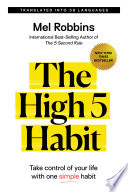

The High 5 Habit emphasizes the importance of self-affirmation as a foundational practice for building self-esteem and confidence. The act of recognizing and celebrating one’s own achievements, no matter how small, can significantly shift one’s mindset from negative to positive. This habit encourages individuals to look in the mirror and give themselves a high five, symbolizing self-acceptance and acknowledgment of personal worth. By regularly practicing self-affirmation, individuals can combat feelings of inadequacy and foster a more positive self-image, which is essential for personal growth and resilience in facing life’s challenges.
Continue readingThe book advocates for a proactive mindset shift, where individuals consciously choose to focus on their strengths and potential rather than their limitations. This shift is crucial for overcoming self-doubt and fear of failure. The High 5 Habit teaches readers to replace negative self-talk with constructive affirmations that empower them to take action. By adopting a growth mindset, individuals can view challenges as opportunities for learning and improvement. This perspective not only enhances personal development but also fosters a more fulfilling and optimistic outlook on life.
Continue readingResilience is a key theme in The High 5 Habit, as it equips individuals with the tools to bounce back from setbacks and adversity. The practice of giving oneself a high five serves as a reminder that failure is not the end, but rather a stepping stone to success. The book provides strategies for cultivating resilience, such as reframing negative experiences and focusing on solutions rather than problems. By nurturing resilience, individuals can better navigate life’s ups and downs, maintaining motivation and determination even in the face of challenges.
Continue readingThe High 5 Habit highlights the significance of community and support systems in personal growth. The book encourages readers to surround themselves with positive influences and engage in relationships that uplift and inspire them. By sharing their goals and progress with others, individuals can create a sense of accountability and motivation. The power of community fosters a collaborative environment where individuals can celebrate each other’s successes, further reinforcing the habit of self-affirmation and collective growth.
Continue readingEstablishing daily rituals is a practical takeaway from The High 5 Habit. The book outlines the importance of incorporating the high five practice into daily routines, making it a consistent habit that reinforces self-love and positivity. By dedicating time each day to reflect on achievements and set intentions, individuals can create a structured approach to personal development. These rituals serve as anchors that ground individuals, helping them stay focused on their goals and maintain a positive mindset amidst daily distractions.
Continue readingVisualization is another powerful technique discussed in The High 5 Habit. The book encourages readers to visualize their goals and the person they aspire to become. By imagining success and the steps needed to achieve it, individuals can enhance their motivation and clarity. Visualization acts as a mental rehearsal, preparing individuals to take action and face challenges with confidence. This practice not only boosts self-belief but also aligns one’s actions with their desired outcomes, making it a valuable tool for achieving personal and professional goals.
Continue readingThe final key idea in The High 5 Habit is the importance of celebrating progress, no matter how incremental. The book emphasizes that acknowledging small victories is crucial for maintaining motivation and momentum in personal growth. By celebrating achievements, individuals reinforce positive behaviors and cultivate a sense of accomplishment. This practice encourages a focus on the journey rather than just the destination, fostering a more fulfilling experience as individuals work towards their goals. Celebrating progress also helps to sustain a positive mindset, making it easier to tackle future challenges.
Continue reading